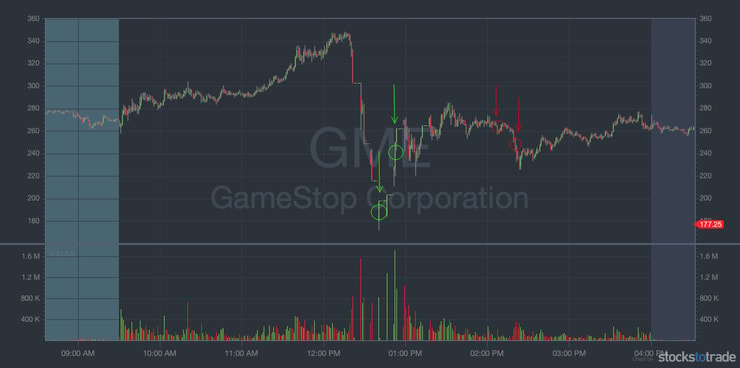Days to Cover: Key Takeaways
- How to use days to cover to find potential trades…
- What you need to know about this short-interest indicator…
- How to identify short-squeeze targets…
SUBSCRIBE to my NO-COST weekly stock watchlist here.
Days to cover needs to be in your toolkit. It’s a versatile indicator that does more than it says in the meme stock age. Can it help you make trades? Let’s find out…
Table of Contents
- 1 What Is Days to Cover?
- 2 How Is Days to Cover Calculated?
- 3 High Days-to-Cover Ratio + Example
- 4 Low Days-to-Cover Ratio + Example
- 5 The Short Selling Process and Days to Cover
- 6 How to Find Short-Interest Data
- 7 How to Trade Using Days to Cover
- 8 Days to Cover: Frequently Asked Questions
- 9 Where Can I Find Days-to-Cover Data?
- 10 What Is a Good Short Ratio?
- 11 How Long Does a Short Seller Have to Cover?
- 12 Days to Cover: The Bottom Line
What Is Days to Cover?

Days to cover is one of the basic indicators of short interest.
On its own, short interest won’t tell you much. You need to add volume to the mix…
That gives you a more accurate picture of how much time shorts need to get out of their positions — which is a great way to assess short-squeeze potential.
Days to cover is a lagging indicator, though. So it looks at a stock’s past performance. But it can be predictive too. Although it charts past volume, increased volume can also signal demand.
When traders buy a stock, they push up the price. This upward trend puts pressure on the shorts, who begin to lose money.
Shorts buy to cover, pushing the price up further … which sets the table for a short squeeze.
This indicator isn’t a magic bullet.
When the days to cover a stock’s short interest is high, that’s a bearish sign. There’s a good chance the stock will continue to behave the way shorts think…
Of course, that didn’t happen for GameStop (NYSE: GME) shorts when they had a higher days-to-cover ratio. The stock squeezed to unseen levels.
Some of my students profited from GME’s 2021 run.* How did they know how to trade a stock that most of the market was certain would trend down?
Prepared traders know it’s important to be ready for ANYTHING.
Demand is only half of the picture. To understand a stock’s total picture, you also need to know its supply.
Outstanding shares are the total supply picture. This includes the entire public float PLUS all of the company’s restricted shares.
These restricted shares are part of the total supply, but they don’t often come into play because they’re given to employees. And certain conditions need to be met before they can be sold.
The public float is a more reliable metric for supply. These are the publicly available shares, which can be bought and sold unconditionally.
Other factors, like dilution, can also impact supply. Dilution is when a company issues new shares, adding to the total outstanding shares.
We saw this happen earlier this year with AMC Entertainment Holdings Inc. (NYSE: AMC)’s big run. Dilution impacted the days-to-cover metric and gave shorts a bit more breathing room.
How Is Days to Cover Calculated?

It isn’t complex. Take the short interest in a stock and divide it by the average trading volume. That’s the time it would take for shorts to exit their positions — in theory.
It doesn’t mean all short sellers will cover their positions in the time the indicator shows.
Days to cover assumes that shorts are trading smart, which isn’t always the case.
I didn't think anyone would be dumb enough to short low priced plays like $TSNP $SUTI $AWGI $ALPP $CBBT but I will say there's a record number of complete morons trading these days & over-aggressive short selling is a common virus lately so it is possible LOL, I just go long 🙂
— Timothy Sykes (@timothysykes) November 28, 2020
The indicator supposes that shorts will cut losses quickly. This is something I tell my students to do. But you can’t expect that behavior from every trader.
Many traders hold and hope. They hold onto positions even when they’re losing money. They abandon their trading plan … if they ever had one. This sets the table for big losses. This mindset is why most traders lose.
Days-to-Cover Formula
Let’s say the short interest in a stock is five million shares. If the trading volume is 10 million shares per day, that’s a 0.5 days-to-cover ratio.
The formula looks like this:
5,000,000 / 10,000,000 = 0.5
Now let’s say that same stock trades one million shares per day. This changes the math dramatically…
5,000,000 / 1,000,000 = 5
What’s considered a high days-to-cover ratio?
Some people consider a days-to-cover ratio above 3 high. Others look for a number between 8 and 10.
In the meme stock age, days to cover has taken on a new meaning. Any significant number might start a Reddit feeding frenzy.
High Days-to-Cover Ratio + Example

According to StocksToTrade, the trading platform I use, Big 5 Sporting Goods Corp. (NASDAQ: BGFV) currently has a days-to-cover ratio near 7.** Some websites use older data, so be mindful of that. You want the most current information.
BGFV’s number isn’t the highest out there. But it does have one of the highest days to cover of stocks with high short interest.
This is one of the best ways to use this indicator — in combination with other indicators. It’s only one sign of a stock’s short-squeeze potential…
You need to combine it with another indicator like short interest. Then you can develop some ideas.
Check out BFGV’s six-month chart.

Its average trading volume is under one million shares per day.
Look back at early May, when the stock ran all the way from $19 to $35. See those big volume numbers? That’s increased demand … and an essential ingredient for a short squeeze.
BGFV’s days-to-cover ratio wasn’t even that high then. It was somewhere closer to 3. You don’t need a big days-to-cover ratio for a stock to squeeze.
Low Days-to-Cover Ratio + Example

The days to cover and short interest on AMC weren’t exceptional earlier this year. The stock ran because of crazy buying pressure.
On January 15, before AMC made its first big run of the year, its days-to-cover ratio was 0.6.
When GME’s short interest was highest, its days-to-cover ratio sat at 2.5 … Then it fell to 0.7 on January 29.
Both stocks went on to make their 2021 runs with a low days-to-cover ratio. The increased volume was the biggest difference…
That’s one reason why you need to pay attention to volume.
Let’s look at two profitable GME trades from March 10 — when the days to cover was less than 0.4.
Millionaire trader Jack Kellogg used step #5 of my 7-Step Pennystocking Framework to dip buy an intraday panic for $107,000.*
Then he used step #6 — The Dead Pump Bounce — for a $100,000 profit.*

The green arrows and circles point to the step #5 pattern he used. The red arrows and circles are step #6.
Millionaire trader Kyle Williams runs StocksToTrade’s alert service Breakouts & Breakdowns along with Jack.** Kyle alerted the step #5 pattern to the chat room — and traded it for a total of $34,000.*

GME’s short interest was still significant when these trades were made. The stock didn’t need a high days-to-cover ratio to squeeze.
The squeeze itself was just one part of the GME saga. Jack went short for his second trade. It’s all about picking your spots.
The Short Selling Process and Days to Cover
Short selling is supposed to be the flip side of going long…
So when did short selling become a cult?
Like so many things the internet ruined, it probably happened when Twitter came along.
This is for all the $LTRPB short sellers, my prayers go out to you & your families for thinking it was a great short in the 40s-50s since it was up from 5, but now at 123 as you can it's the same type of $DRYS squeeze a few years back! pic.twitter.com/3tY7dSCOeA
— Timothy Sykes (@timothysykes) April 15, 2020
I teach because there’s SO much bad information out there. Too many traders think that stocks only go up…
And some think the other way, that the stock they’re shorting is bound to come down.
Neither perspective is right. I teach my students to watch the market and pay attention to indicators…
Most importantly, I want you to REACT to the market.
There’s no magic indicator that can predict a stock’s future. You have to learn as much as you can. Then you have to react quickly to what the market tells you.
I don’t teach the shortcuts approach in my Trading Challenge. I give my students the tools to become self-sufficient traders. Then I give them the support to put their knowledge into practice.
I don’t accept everyone…
If you think you’ve got what it takes, apply for my Trading Challenge here.
How to Find Short-Interest Data

FINRA requires all securities to report short interest twice a month.
Hopefully, you’re using a top-notch trading platform like StocksToTrade.** Short interest and every other indicator should be a quick toggle away.
How to Trade Using Days to Cover
So how can you use this indicator for your trades?
You can use it as one potential sign of short-squeeze potential. It has to be part of the total picture.
Self-sufficient traders know enough about themselves to know and understand what works for them. If days to cover gives you that trading edge, keep an eye on it.
If not, don’t worry about it.
Days to Cover: Frequently Asked Questions
Forgive the pun, there are still a few questions to cover…
Where Can I Find Days-to-Cover Data?
Days-to-cover data is based on short interest reported to FINRA. If you have a good trading platform, it should be easy to find.
What Is a Good Short Ratio?
Short ratio is another term for days to cover. If you’re looking for short-squeeze potential, you want a high number.
How Long Does a Short Seller Have to Cover?
Shorts can take as long as they want to cover. But the fees will add up for them...
Days to Cover: The Bottom Line
More than most indicators, days to cover depends on other factors…
When they all line up, they can pave the way for profitable trades.
If you came here looking for a get-rich-quick plan, I’m sorry to disappoint you. But if you came here to build your knowledge base — you’re well on your way.
What do YOU think about this indicator? Have you used it in your trades? Let me know in the comments — I love hearing from my readers!
Disclaimers
*Results are not typical and will vary from person to person. Making money trading stocks takes time, dedication, and hard work. Most who receive free or paid content will make little or no money because they will not apply the skills being taught. Any results displayed are exceptional. We do not guarantee any outcome regarding your earnings or income as the factors that impact such results are numerous and uncontrollable. I’ve also hired Jack and Kyle to help in my education business.
While Tim Sykes has enjoyed remarkable success trading stocks over the years, earning an aggregate sum of over $7 million in trading profits between 1999 and 2021, his primary income derives from the sale of financial education products and subscription services offered by various businesses and websites in which he has an ownership stake. I’ve also hired Jack Kellogg and Kyle Williams to help in my education business.
**Tim Sykes has a minority ownership stake in StocksToTrade.com.








Leave a reply